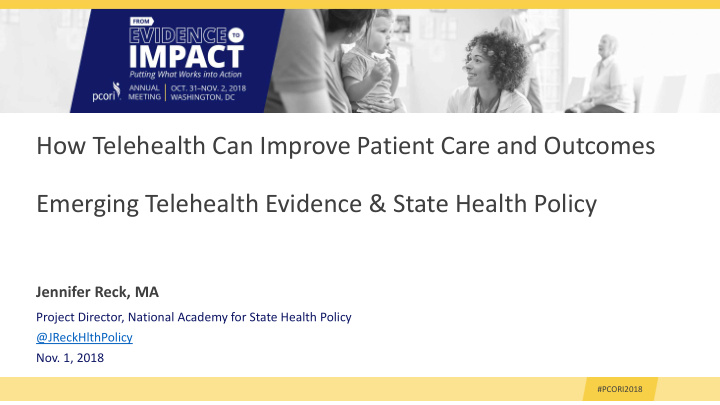



How Telehealth Can Improve Patient Care and Outcomes Emerging Telehealth Evidence & State Health Policy Jennifer Reck, MA Project Director, National Academy for State Health Policy @JReckHlthPolicy Nov. 1, 2018 #PCORI2018
Jennifer Reck • Has nothing to disclose. 2 • November 1, 2018
National Academy for State Health Policy (NASHP) • Non-profit, non-partisan • Washington, DC & Portland, ME • 31 years serving states • Academy = leaders in state health policy working across agencies & branches of government • PCORI Engagement Awards: • Roadmap for using PCOR and CER in Policymaking • Learning Collaborative to put the roadmap to work (AL, CO, MA) • PCOR Work Group: exploring policy implications of emerging research 3 • November 1, 2018
Why are state policymakers interested in telehealth? High level of interest in telehealth – To improve access & address work force shortages: • In underserved, esp. rural areas • To specialty providers • e.g. behavioral health, substance use, dermatology, psychiatry • In response to opioid epidemic 4 • November 1, 2018
Snapshot of State Telehealth Legislation • 39 state laws related to telehealth passed in 2018 session • Broadband (4) • Demonstrations, grants, and pilots (4) • Medicaid Reimbursement (10) • Regulatory, licensing, & advisory boards (10) • Cross-state licensing (3) • Private Payer Reimbursement (7) • Provider/Patient Relationships (4) • Substance Use Disorder (8) *bills covering multiple issues are double counted above 5 • November 1, 2018
Barriers to Adoption of Telehealth Interventions • Payment: 1. Lack of coverage alignment across payers 2. Facility fees “It’s a little risky to think of telemedicine as a solution to rural health access if you don’t think about the payment for it.” - NASHP PCOR Work Group Member 6 • November 1, 2018
1. Lack of Alignment Across Payers • State officials report sometime limited uptake of telehealth in public programs despite coverage • Possible explanation: Lack of coverage alignment across private and public payers can inhibit use by providers • Policy response: • State lawmakers in 35 states and Washington, DC have passed parity laws to require private insurers to cover telehealth 7 • November 1, 2018
2. Facility Fees • Hospitals (or hospital-owned clinics) often charge a facility fee to cover their overhead costs • Only 32 state Medicaid programs allow payment of a facility fee (or transmission fee) when telehealth is used 8 • November 1, 2018
Additional Information Needed to Change Practice State health policymakers want to know if telehealth results in better patient outcomes, AND - • Are telehealth interventions cost-effective? • Does a telehealth intervention replace existing in-person care? Or does it create new costs for additional care? • How does telehealth fit into existing payment models? 9 • November 1, 2018
Learn More • www.nashp.org • https://nashp.org/overcoming-payment-challenges-to-realize- the-promise-of-telehealth/ 10 • November 1, 2018
Thank You! Jennifer Reck, MA Project Director, National Academy for State Health Policy @JReckHlthPolicy November 1, 2018 11 • November 1, 2018
Moderated Panel Discussion 12 • November 1, 2018
Questions? 13 • November 1, 2018
Thank You! Penny Mohr Senior Advisor, Emerging Technology and Delivery System Innovation Research Initiatives Healthcare Delivery and Disparities Research November 1 st , 2018 14 • November 1, 2018
Recommend
More recommend